Margrethe II of Denmark
Margrethe II (pronounced [mɑˈkʁeˀtə]; born Margrethe Alexandrine Þórhildur Ingrid; 16 April 1940) is the Queen of Denmark, the supreme authority of the Church of Denmark and the commander-in-chief of the Danish Defence. Born into the House of Glücksburg, a royal house with origins in northern Germany, she was the eldest child of Frederick IX of Denmark and Ingrid of Sweden. She became heir presumptive to her father in 1953, when a constitutional amendment allowed women to inherit the throne.
| Margrethe II | |||||
|---|---|---|---|---|---|
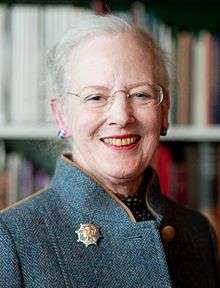 Margrethe in May 2012 | |||||
| Queen of Denmark | |||||
| Reign | 14 January 1972 – present | ||||
| Predecessor | Frederick IX | ||||
| Heir apparent | Frederik | ||||
| Prime Ministers | See list
| ||||
| Born | 16 April 1940 Amalienborg, Copenhagen, Occupied Denmark | ||||
| Spouse | Henri de Laborde de Monpezat
( m. 1967; died 2018) | ||||
| Issue Detail | |||||
| |||||
| House | Glücksburg[1] | ||||
| Father | Frederick IX of Denmark | ||||
| Mother | Ingrid of Sweden | ||||
| Religion | Church of Denmark | ||||
| Signature | |||||
| Danish royal family |
|---|
 |
|
HM Queen Anne-Marie of Greece |
| Extended royal family |
Margrethe succeeded her father upon his death on 14 January 1972. On her accession, she became the first female monarch of Denmark since Margrethe I, ruler of the Scandinavian kingdoms in 1375–1412 during the Kalmar Union. In 1967, she married Henri de Laborde de Monpezat, with whom she had two sons: Crown Prince Frederik and Prince Joachim.
Early life

Princess Margrethe was born 16 April 1940 at Amalienborg in Copenhagen as the first child of the Crown Prince and Crown Princess (later King Frederick IX and Queen Ingrid). Her father was the eldest son of the then-reigning King Christian X, while her mother was the only daughter of the Crown Prince of Sweden (later King Gustaf VI Adolf). Her birth took place just one week after Nazi Germany's invasion of Denmark on 9 April 1940.[2]
She was baptised on 14 May in the Holmen Church in Copenhagen.[2] The Princess's godparents were: King Christian X (paternal grandfather); Hereditary Prince Knud (paternal uncle); Prince Axel (her paternal grandfather's first cousin); King Gustaf V of Sweden (maternal great-grandfather); Crown Prince Gustaf Adolf of Sweden (maternal grandfather); Prince Gustaf Adolf, Duke of Västerbotten (her maternal uncle); Prince Arthur, Duke of Connaught and Strathearn (maternal great-grandfather).
She was named Margrethe after her late maternal grandmother, Crown Princess Margaret of Sweden, Alexandrine after her paternal grandmother, Queen Alexandrine, and Ingrid after her mother. Since her paternal grandfather was also the King of Iceland, she was given the Icelandic name Þórhildur.[3]
When Margrethe was four years old, in 1944, her younger sister Princess Benedikte was born. Princess Benedikte later married Prince Richard of Sayn-Wittgenstein-Berleburg and lives some of the time in Germany. Her second sister, Princess Anne-Marie, was born in 1946. Anne-Marie later married Constantine II of the Hellenes and currently lives in Greece.
Margrethe and her sisters grew up in apartments at Frederick VIII's Palace at Amalienborg in Copenhagen and in Fredensborg Palace in North Zealand. She spent summer holidays with the royal family in her parent's summer residence at Gråsten Palace in Southern Jutland. On 20 April 1947, King Christian X died and Margrethe's father ascended the throne as King Frederick IX.
She is "known affectionately as Daisy".[4]
Heir presumptive
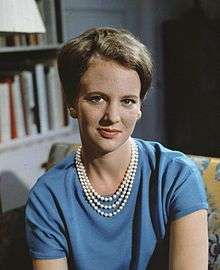
At the time of her birth, only males could ascend the throne of Denmark, owing to the changes in succession laws enacted in the 1850s when the Glücksburg branch was chosen to succeed. As she had no brothers, it was assumed that her uncle Prince Knud would one day assume the throne.
The process of changing the constitution started in 1947, not long after her father ascended the throne and it became clear that Queen Ingrid would have no more children. The popularity of Frederick and his daughters and the more prominent role of women in Danish life started the complicated process of altering the constitution. The law required that the proposal be passed by two successive Parliaments and then by a referendum, which occurred 27 March 1953. The new Act of Succession permitted female succession to the throne of Denmark, according to male-preference cognatic primogeniture, where a female can ascend to the throne only if she does not have a brother. Princess Margrethe therefore became heir presumptive.[2]
On her eighteenth birthday, 16 April 1958, Margrethe was given a seat in the Council of State. She subsequently chaired the meetings of the Council in the absence of the King.[2]
In 1960, together with the princesses of Sweden and Norway, she travelled to the United States, which included a visit to Los Angeles, and to the Paramount Studios, where they met several celebrities, including Dean Martin, Jerry Lewis and Elvis Presley.[5]
Education
Margrethe was educated at the private school N. Zahle's School in Copenhagen from which she graduated in 1959. She spent a year at North Foreland Lodge, a boarding school for girls in Hampshire, England,[6] and later studied prehistoric archaeology at Girton College, Cambridge, during 1960–1961, political science at Aarhus University between 1961 and 1962, attended the Sorbonne in 1963, and was at the London School of Economics in 1965.[7] She is a Fellow of the Society of Antiquaries of London.[2]
Queen Margrethe is fluent in Danish, French, English, Swedish and German, and has a limited knowledge of Faroese.[2][7]
Marriage and children

Princess Margrethe married a French diplomat, Henri de Laborde de Monpezat, 10 June 1967, at the Holmen Church in Copenhagen. Laborde de Monpezat received the style and title of "His Royal Highness Prince Henrik of Denmark" because of his new position as the spouse of the heir presumptive to the Danish throne.[2] They were married for over fifty years, until his death on 13 February 2018.
Margrethe gave birth to her first child 26 May 1968. By tradition, Danish kings were alternately named either Frederik or Christian. She chose to maintain this by assuming the position of a Christian, and thus named her eldest son Frederik. A second child, named Joachim, was born 7 June 1969.[2]
Reign

Succession
Shortly after King Frederick IX delivered his New Year's Address to the Nation at the 1971/72 turn of the year, he fell ill. At his death 14 days later, 14 January 1972, Margrethe succeeded to the throne at the age of 31, becoming the first female Danish sovereign under the new Act of Succession. She was proclaimed Queen from the balcony of Christiansborg Palace 15 January 1972 by Prime Minister Jens Otto Krag. Queen Margrethe II relinquished all the monarch's former titles except the title to Denmark, hence her style "By the Grace of God, Queen of Denmark" (Danish: Margrethe den Anden, af Guds Nåde Danmarks Dronning). The Queen chose the motto: God's help, the love of The People, Denmark's strength.[7]
In her first address to the people, Queen Margrethe II said:
My beloved father, our King, is dead. The task that my father had carried for nearly 25 years is now resting on my shoulders. I pray to God to give me help and strength to carry the heavy heritage. May the trust that was given to my father also be granted to me.[8]
Constitutional role
The Queen's main tasks are to represent the Kingdom abroad and to be a unifying figure at home. The Queen performs the latter task by accepting invitations to open exhibitions, attending anniversaries, inaugurating bridges, etc. She receives foreign ambassadors and awards honours and medals.
As an unelected public official, the Queen takes no part in party politics and does not express any political opinions. Although she has the right to vote, she opts not to do so to avoid even the appearance of partisanship.[2]
The Queen holds a meeting with the prime minister and the foreign affairs minister every Wednesday, unless she or the prime minister is outside of the kingdom.
After an election where the incumbent prime minister does not have a majority behind him or her, the Queen holds a "Dronningerunde" (Queen's meeting) in which she meets the chairmen of each of the Danish political parties.[9]
Each party has the choice of selecting a royal investigator to lead these negotiations or alternatively, give the incumbent prime minister the mandate to continue his or her government as is. In theory each party could choose its own leader as royal investigator, the social liberal Det Radikale Venstre did so in 2006, but often only one royal investigator is chosen plus the prime minister, before each election. The leader who, at that meeting succeeds in securing a majority of the seats in the Folketing, is by royal decree charged with the task of forming a new government. (It has never happened in more modern history that any party has held a majority on its own.)
Once the government has been formed, it is formally appointed by the Queen. Officially, it is the Queen who is the head of government, and she therefore presides over the Council of State (privy council), where the acts of legislation which have been passed by the parliament are signed into law. In practice, however, nearly all of the Queen's formal powers are exercised by the Cabinet of Denmark.
In addition to her roles in her own country, the Queen is also the colonel-in-chief of the Princess of Wales's Royal Regiment (Queen's and Royal Hampshires), an infantry regiment of the British Army, following a tradition in her family.[2]
Ruby Jubilee
Queen Margrethe II celebrated her Ruby Jubilee, the 40th year on the throne, on 14 January 2012.[10] This was marked by a carriage procession, a gala banquet at Christiansborg Palace and numerous TV interviews.
Immigration debate
In an interview within the 2016 book De dybeste rødder (The Deepest Roots), according to historians at the Saxo Institute of the University of Copenhagen she showed a change in attitude to immigration towards a more restrictive stance. She stated that the Danish people should have more explicitly clarified the rules and values of Danish culture in order to be able to teach them to new arrivals. She further stated that the Danes in general have underestimated the difficulties involved in successful integration of immigrants, exemplified with the rules of a democracy not being clarified to Muslim immigrants and a lack of readiness to enforce those rules. This was received as a change in line with the attitude of the Danish people.[11][12]
Personal life and interests
The official residences of the Queen are Amalienborg Palace in Copenhagen and Fredensborg Palace. Her summer residence is Gråsten Palace near Sønderborg, the former home of her mother, Queen Ingrid, who died in 2000.
Margrethe is an accomplished painter, and has held many art shows over the years. Her illustrations—under the pseudonym Ingahild Grathmer—were used for Danish editions of The Lord of the Rings, which she was encouraged to illustrate in the early 1970s. She sent them to J. R. R. Tolkien, who was struck by the similarity of her drawings to his own style. Margrethe's drawings were redrawn by the British artist Eric Fraser for the Folio Society's English edition of The Lord of the Rings, first published in 1977 and reissued in 2002. In 2000, she illustrated Henrik, the Prince Consort's poetry collection Cantabile. She is also an accomplished translator and is said to have participated in the Danish translation of The Lord of the Rings.[7] Another skill she possesses is costume designing, having designed the costumes for the Royal Danish Ballet's production of A Folk Tale and for the 2009 Peter Flinth film, De vilde svaner (The Wild Swans).[2][13] She also designs her own clothes and is known for her colourful and sometimes eccentric clothing choices. Margrethe also wears designs by former Pierre Balmain designer Erik Mortensen, Jørgen Bender, and Birgitte Taulow.[14] The Guardian in March 2013 listed her as one of the fifty best-dressed over 50s.[15]
Margrethe is a chain smoker, and she is famous for her tobacco habit.[16] However, on 23 November 2006, the Danish newspaper B.T. reported an announcement from the Royal Court stating that in the future the Queen would smoke only in private.[17]
Family
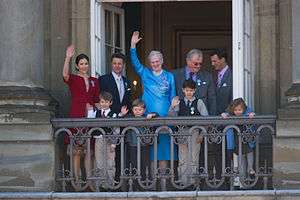
The Queen has two children and eight grandchildren, all born at Rigshospitalet in Copenhagen:
- Crown Prince Frederik (born 26 May 1968). He was married to Mary Donaldson on 14 May 2004 at Copenhagen Cathedral, Copenhagen. The couple have four children:
- Prince Christian (born 15 October 2005)
- Princess Isabella (born 21 April 2007)
- Prince Vincent (born 8 January 2011)
- Princess Josephine (born 8 January 2011)
- Prince Joachim (born 7 June 1969). He was married to Alexandra Manley on 18 November 1995 at Frederiksborg Palace Church, Hillerød. They divorced on 8 April 2005. He was married secondly to Marie Cavallier on 24 May 2008 at Møgeltønder Church, Møgeltønder. Joachim has four children, three sons and one daughter:
- Prince Nikolai (born 28 August 1999)
- Prince Felix (born 22 July 2002)
- Prince Henrik (born 4 May 2009)
- Princess Athena (born 24 January 2012)
In 2008, the Queen announced that her male-line descendants would bear the additional title of Count or Countess of Monpezat, in recognition of her husband's ancestry.[18]
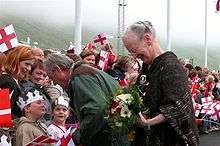
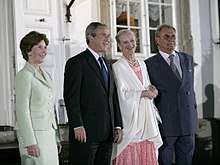
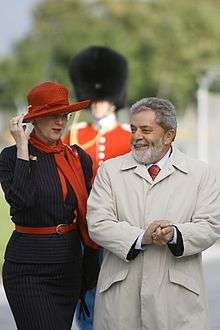
Honours
She is the 1,188th knight of the Order of the Golden Fleece in Spain, and only the 7th Lady of the Order of the Garter since 1901, when Edward VII appointed his consort a member. She is also Colonel-in-Chief of The Princess of Wales's Royal Regiment (Queen's and Royal Hampshires) in the United Kingdom.[19]
Queen Margrethe II Land in Northeast Greenland was named in her honour on 16 April 1990 on the occasion of her 50th birthday.[20]
National

- Cross of Honour of the Order of the Dannebrog (D.Ht.)[21]
- Order of the Elephant[21]
- Air Force Long Service Medal[21]
- Homeguard Medal of Merit[21]
- 25 years of Homeguard Service Medal[21]
- Medal of Honour of the League of Civil Defence[21]
- Medal of Honour of the Reserve Officers League[21]
- 100th Anniversary Medal of the Birth of King Christian X[21]
- 50th Anniversary Medal of the arrival of Queen Ingrid to Denmark[21]
- 100th Anniversary Medal of the Birth of King Frederik IX[21]
- Queen Ingrid Commemorative Medal[21]
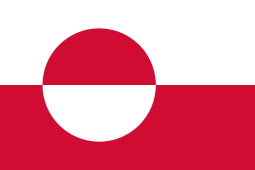
Foreign


.svg.png)









.svg.png)
- Grand Cross of the Order of the Redeemer[21]

.svg.png)


- Collar of the Order of the Chrysanthemum[21]
- Grand Cordon (Paulownia) of the Order of the Precious Crown[21]









- Grand Cross with Collar of the Order of St. Olav[21]
- Recipient of the Silver Jubilee Medal of King Olav V[21]
- Recipient of the Silver Jubilee Medal of King Harald V[26]

- Knight of the Order of the White Eagle[21]
- Grand Cordon of the Order of Merit of the Republic of Poland[21]

- Grand Collar of the Military Order of Saint James of the Sword[21]
- Grand Collar of the Order of Prince Henry[21]





- 1,188th Knight of the Order of the Golden Fleece[21][27]
- Knight Grand Cross with Collar of the Order of Charles III[21][28]

- Member with Collar of the Royal Order of the Seraphim[21]
- Recipient of the 85th Birthday Badge Medal of King Gustaf VI Adolf[21]
- Recipient of the 40th Birthday Badge Medal of King Carl XVI Gustaf[21]
- Recipient of the Ruby Jubilee Badge Medal of King Carl XVI Gustaf[21]



- Knight of the Order of the Rajamitrabhorn[21]
- Knight of the Order of the Royal House of Chakri[21]



.svg.png)
 Royal coat of arms
Royal coat of arms Royal standard
Royal standard Royal monogram of Margrethe II
Royal monogram of Margrethe II Personal monogram of Margrethe II
Personal monogram of Margrethe II Dual monogram of Margrethe II and husband Henrik, Prince Consort
Dual monogram of Margrethe II and husband Henrik, Prince Consort
Ancestry
| Ancestors of Margrethe II of Denmark | |||||||||||||||||||||||||||||||||||||||||||||||||||||||||||||||||||||||||||||||||||||||||||||||||||||||||||||||||||||||||||||||||||||||||||||||||||||||||||||||||||||||||||||||||||||||||||||||||||||||||||||||||||||||||||||||||||||||||||||||||||||||||||||||||||||||||||||||||||||||||
|---|---|---|---|---|---|---|---|---|---|---|---|---|---|---|---|---|---|---|---|---|---|---|---|---|---|---|---|---|---|---|---|---|---|---|---|---|---|---|---|---|---|---|---|---|---|---|---|---|---|---|---|---|---|---|---|---|---|---|---|---|---|---|---|---|---|---|---|---|---|---|---|---|---|---|---|---|---|---|---|---|---|---|---|---|---|---|---|---|---|---|---|---|---|---|---|---|---|---|---|---|---|---|---|---|---|---|---|---|---|---|---|---|---|---|---|---|---|---|---|---|---|---|---|---|---|---|---|---|---|---|---|---|---|---|---|---|---|---|---|---|---|---|---|---|---|---|---|---|---|---|---|---|---|---|---|---|---|---|---|---|---|---|---|---|---|---|---|---|---|---|---|---|---|---|---|---|---|---|---|---|---|---|---|---|---|---|---|---|---|---|---|---|---|---|---|---|---|---|---|---|---|---|---|---|---|---|---|---|---|---|---|---|---|---|---|---|---|---|---|---|---|---|---|---|---|---|---|---|---|---|---|---|---|---|---|---|---|---|---|---|---|---|---|---|---|---|---|---|---|---|---|---|---|---|---|---|---|---|---|---|---|---|---|---|---|---|---|---|---|---|---|---|---|---|---|---|---|---|---|---|---|
| |||||||||||||||||||||||||||||||||||||||||||||||||||||||||||||||||||||||||||||||||||||||||||||||||||||||||||||||||||||||||||||||||||||||||||||||||||||||||||||||||||||||||||||||||||||||||||||||||||||||||||||||||||||||||||||||||||||||||||||||||||||||||||||||||||||||||||||||||||||||||
Patrilineal descent
See also
- Monarchy of Denmark
- List of current sovereign monarchs
- List of national leaders
References
- "150 years of the House of Glücksborg". Retrieved 25 October 2014.
- "Her Majesty Queen Margrethe II". Kongehuset.dk. Retrieved 11 December 2014.
- "Navnet til den ny prinsesse..." nfi.ku.dk. Nordisk Forskningsinstitut, University of Copenhagen. 18 May 2012. Archived from the original on 2 February 2017. Retrieved 23 January 2017.
- Morris, Chris (13 January 2012). "Denmark's Queen Margrethe marks 40 years". BBC News.
- "Elvis Presley with Princesses Margrethe of Denmark, Astrid of Norway, and Margaretha of Sweden". Elvispresleymusic.com.au. 7 June 1960. Archived from the original on 9 September 2015. Retrieved 11 December 2014.
- "Princess Margrethe, who is fifteen and is heir presumptive to the Danish throne, is to study for a year in England at North Foreland Lodge, a girls' boarding school near Basingstoke, in Hampshire...". The Illustrated London News. 227 (2). 1955. p. 552.
- "Margrethe and Henrik Biography". Royalinsight.net. 16 April 1940. Archived from the original on 30 October 2011. Retrieved 3 February 2012.
- "Queen Margrethe II of Denmark 40 years on the Throne". Radical Royalist. 13 January 2012. Retrieved 11 December 2014. Cite journal requires
|journal=(help) - "The Monarchy today". Kongehuset.dk. Archived from the original on 15 February 2015. Retrieved 11 December 2014.
- "Queen Margrethe II of Denmark marks 40 years on the throne". BBC News. 12 January 2012.
- "Historiker om Margrethes danskheds-udtalelse: - Hun har fulgt folkesjælens bekymringer". TV2 (Denmark). 23 October 2016. Retrieved 25 October 2016.
- "Dronning Margrethe om integration: "Det er ikke en naturlov, at man bliver dansker af at bo i Danmark"". Berlingske Tidende. 22 October 2016. Retrieved 25 October 2016.
- "De vilde svaner (2009)". Internet Movie Database. Retrieved 11 December 2014.
- "Flashback Friday: Queen Margrethe's Styl". The Royal Order of Sartorial Splendor. 13 January 2012. Retrieved 3 February 2012. Cite journal requires
|journal=(help) - Cartner-Morley, Jess; Mirren, Helen; Huffington, Arianna; Amos, Valerie (28 March 2013). "The 50 best-dressed over 50s". The Guardian. Manchester.
- Isherwood, Julian (23 March 2001). "Danish royals angry at cancer accusation". BBC News. Retrieved 11 December 2014.
- "Margrethe skruer ned for røgen". Archived from the original on 16 October 2007. Retrieved 7 May 2014.CS1 maint: BOT: original-url status unknown (link). bt.dk. 26 November 2006
- "Monpezat til Frederik og Joachim" [Monpezat for Frederik and Joachim]. Berlingske Tidende. 30 April 2008. Retrieved 11 December 2014.
- "No. 54745". The London Gazette (Supplement). 21 April 1997. p. 4766.
- Higgins, Anthony K. (2010). "Catalogue of place names in northern East Greenland" (PDF). Exploration history and place names of northern East Greenland. Geological Survey of Denmark and Greenland. p. 158. Retrieved 22 August 2019.
- "Dekorationer". Kongehuset.dk. Archived from the original on 24 June 2020. Retrieved 24 June 2020.
- "Bundeskanzler Anfragebeantwortung An die Präsidentin des Nationalrats" [Reply to a parliamentary question about the Decoration of Honour] (PDF). Parlament.gv.at (in German). p. 168. Retrieved 1 November 2012.
- "Fálkaorðuhafar" [Holders of the Commander's Cross]. The President of Iceland. Archived from the original on 20 December 2014. Retrieved 11 December 2014.
- "Apdovanojimai" [Awards Database]. President of the Republic of Lithuania. Archived from the original on 19 April 2014. Retrieved 11 December 2014.
- "ACUERDO por el que se otorga a Su Majestad Margrethe II Reina de Dinamarca, la Condecoración de la Orden Mexicana del Aguila Azteca en el grado de Collar" [AGREEMENT that the Collar of the Order of the Aztec Eagle is awarded to Her Majesty Queen Margrethe II of Denmark]. Secretariat of the Interior. 13 February 2008. Retrieved 11 December 2014.
- "Tildeling av Kong Harald Vs jubileumsmedalje 1991-2016". Kongehuset (in Norwegian). Retrieved 20 January 2016.
- "REAL DECRETO 1948/1985. de 23 de octubre. por el Que se concede el Collar de la Insigne Orden del Toisón de Oro a Su Majestad Margarita ll, Reina de Dinamarca" [Her Majesty Margrethe II, Queen of Denmark is awarded the Collar of the Illustrious Order of the Golden Fleece] (PDF). Boletín Oficial del Estado. 24 October 1985. Retrieved 11 December 2014.
- "REAL DECRETO 738/1980, de 15 de marzo, por el que se concede el Collar de la Real y Muy Distinguida Orden de Carlos Ill a Su Majestad Margarita ll, Reina de Dinamarca" [Royal Decree 738/1980 of 15 March, granting the Collar of the Royal and Most Distinguished Order of Carlos III Margarita ll to Her Majesty, Queen of Denmark] (PDF). Boletín Oficial del Estado. 24 April 1980. Retrieved 11 December 2014.
Bibliography
- Anderse, Jens (2011). Nørholm, Elise H. (ed.). M, 40 år på tronen (in Danish) (1st ed.). Copenhagen: Lindhardt og Ringhof. ISBN 9788711419694.
- Dehn-Nielsen, Henning (2005). Margrethe 2., Danmarks dronning (in Danish) (3rd ed.). Copenhagen: Aschehoug. ISBN 8711222832.
- Lyding, Henrik (2009). Dronningens teater (in Danish). Copenhagen: Gyldendal. ISBN 9788702078787.
- Margrethe II (2012). Andersen, Jens (ed.). Om man så må sige, 350 Dronning Margrethe-citater (in Danish). Copenhagen: Lindhardt og Ringhof. ISBN 9788711394168.
- Rubinstein, Mogens (1996). Dronning Margrethe II, 25 år som regent (in Danish). Copenhagen: Møntergården. ISBN 8775535521.
- Skipper, Jon Bloch (2008). Tre søstre, samtaler mellem dronning Margrethe, prinsesse Benedikte og dronning Anne-Marie (in Danish). Copenhagen: Lindhardt og Ringhof. ISBN 9788711300602.
External links
| Wikimedia Commons has media related to Margrethe II of Denmark. |
| Wikiquote has quotations related to: Margrethe II |
- The Queen's Homepage
- The Official Website of The Danish Monarchy
- Tapestries for HM The Queen of Denmark
Margrethe II of Denmark Cadet branch of the House of Oldenburg Born: 16 April 1940 | ||
| Regnal titles | ||
|---|---|---|
| Preceded by Frederick IX |
Queen of Denmark 14 January 1972 – present |
Incumbent Heir apparent: Frederik |
.svg.png)
